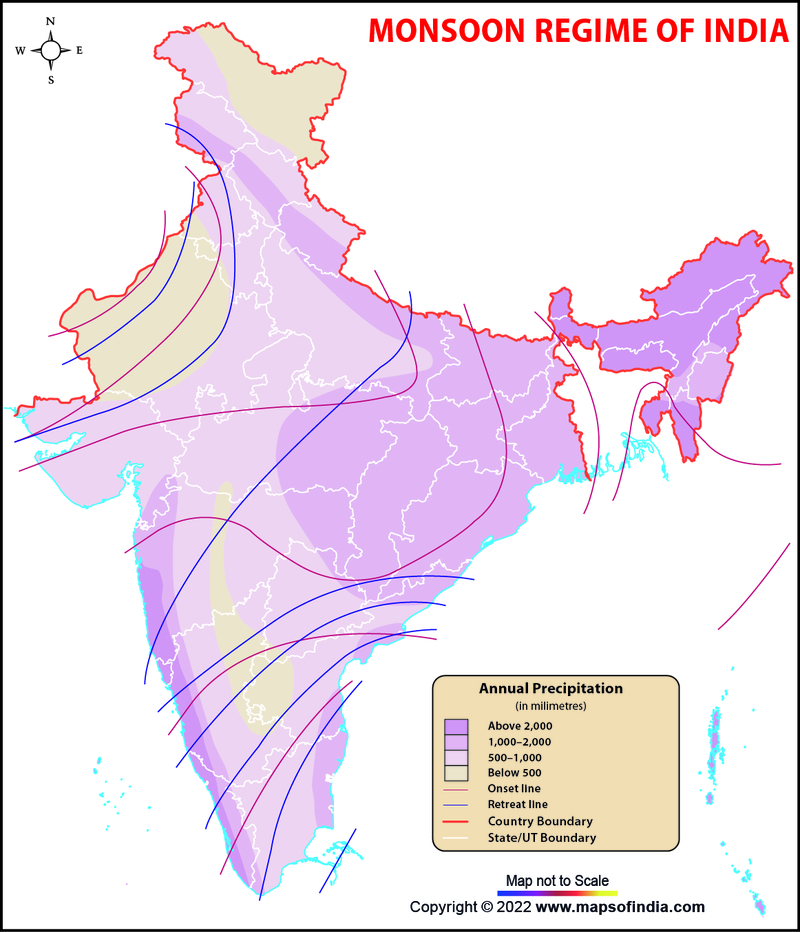The word monsoon is derived from the Arabic word “mawsim”, meaning ‘weather’. It refers to the change in seasonal winds due to the change in season. During summers, it travels from sea to land, while in winters it travels from land to sea. Although the word is generally associated with rainfalls, it can also cause dry spells due to changes in climatic conditions.
India experiences various weather conditions. It majorly has four seasons, summer, monsoon, winter, and spring. All of them have their special characteristics and significance. The climate of India is often described as the ‘monsoon type’ because it is influenced by monsoon winds. Therefore, the Indian monsoons are very prominent across the globe.
Indian Monsoon
The Indian monsoon is among the popular world monsoon systems. It majorly affects India and its neighbouring countries of Bangladesh, Sri Lanka, and Myanmar. India experiences two types of monsoons, Southwest monsoon and Northeast monsoon. Both of them have their causes and effects.
Monsoons in India are closely watched by the Indian Meteorological Department. It is a department under the Ministry of Earth Sciences. It is responsible for observing and forecasting all the information regarding the weather changes in India. It also forecasts the arrival of monsoons in India.
Southwest Monsoon or Advancing Monsoon
The Southwest monsoon or advancing monsoon refers to the monsoon season from June to September. Most of the rainfall in India is received by different parts of the nation during these months. It can also be referred to as the summer monsoon as it occurs during the warmer months. During this monsoon, the wind moves from the Southwest to the Northeast direction.
It is caused because of the low-pressure formation over the Tibetan Plateau as it gets heated during summers. Other factors that influence the Southwest monsoons include the permanent high-pressure cell that is there in the South of the Indian Ocean, subtropical jet stream, African Easterly Jet, and the Inter-Tropical Convergence Zone (ITCZ).
There are two branches of the Southwest Monsoon, the Arabian Sea branch and the Bay of Bengal branch. The former one first hits the Western Ghats in Kerala, making it the first state in the country to receive rains. On the contrary, the state of Tamil Nadu remains dry during these monsoons as it comes under the rain shadow area. Starting from June these monsoon winds travel upwards towards the north and then start retreating during September.
Northeast Monsoon or Retreating Monsoon
The Northeast Monsoon or the Retreating Monsoon begins when the Southwest winds start retreating during October and November and continue till January. The winds move from the Northeast direction to the southwest direction during this monsoon. It is also called the winter monsoon due to its occurrence in the colder months of the year.
Although it remains for a short period, it causes uneven rainfalls in different parts of the country. While the western part of Western Ghats and states of Assam, Arunachal Pradesh, and Sikkim receives heavy rainfalls, Karnataka, Gujarat, and Maharashtra receive low rainfalls. The state of Tamil Nadu which remains dry during the summer monsoon receives most of its rainfall during these monsoons.
- National Science Museums in India
- Jyotirlinga Shrines
- Geological Map of India
- Canals in India
- Major Lakes in India
- Heritage Map of India
- Pin Code Zones in India
- Per Capita Income of India
- Major Sea Ports
- Languages in India
- Climate map of India
- Parlimentary Constituencies in India
- Tourist Circuits in India
- Metallic Minerals in India
- Cold Desert Map
- Major Electricity Generator Plants
- Religions In India
- Major Earthquakes in India
- Major Hydro Power Plants
- Indian States and Union Territories
- Cabinet Ministers
- Map of Indian States and Union Territories Enlarged View
- Physiographic Map of India
- Religious Places in India
- Geographical Map of India
- Dams in India
- India Coal Reserves Map
- India Political Map Enlarged View
- India Satellite Map
- Topographic Map of India
- Population Map Of India
- Natural Hazard Map of India
- Tourist Map of India Enlarged View
- Tier I and Tier II Cities of India
- Cyclone Prone Areas in India
- Outline Map of India Enlarged View
- Wine Producing Regions in India
- Map of Major Airports in India
- Birth Rate in India
- Statehood Movements in India
Last Updated on: November 13, 2025

